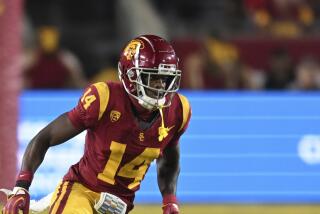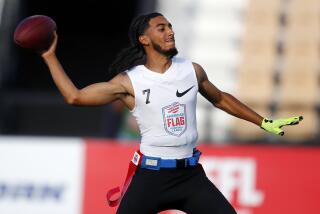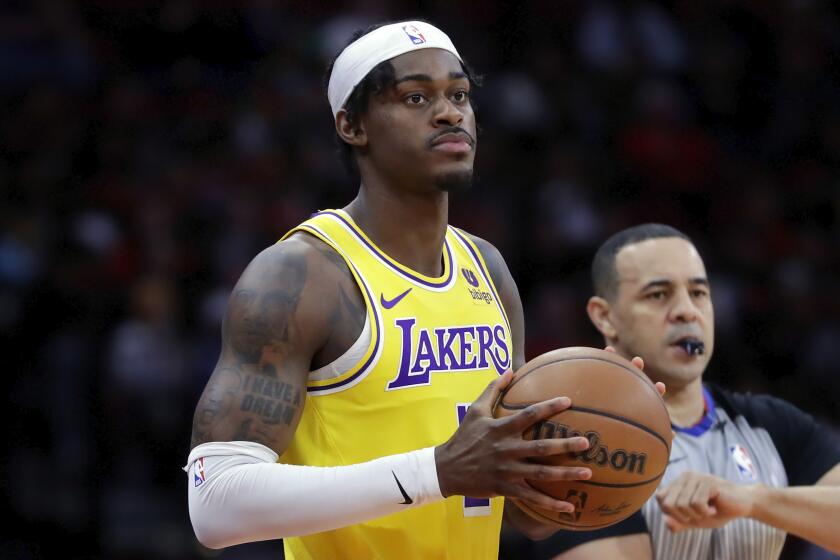NFL DRAFT : Why the NFL Kept Peete Hanging On : And on the Second Day of Draft, Ex-Trojan QB Turns Up as a Lion
- Share via
It was a long wait for Rodney Peete, but he landed on his feet.
The two-time Rose Bowl quarterback from USC will be playing this year for the team that can give him his best chance to succeed in the National Football League.
Or so it seemed Monday when, as the second player chosen on the second day of the draft, Peete went to the NFL’s only run ‘n’ shoot team, the Detroit Lions.
“He’ll be a real good one in that offense,” Gil Brandt, the Dallas Cowboys’ chief scout, said after Detroit picked Peete in the sixth round.
“We’re sure glad to have him,” said Mouse Davis, Detroit’s passing coach and the inventor of the run ‘n’ shoot offense.
“Rodney is a quarterback who has everything--everything to play well in the NFL, enough size, the foot speed, the intelligence and the charisma to lead-- provided his arm is strong enough.
“That’s the big if. We think he has an arm--but it’s an if. The arm explains why he didn’t go in the first five rounds (Sunday).”
In Detroit, Peete will join another rookie, running back Barry Sanders, to give Coach Wayne Fontes’ team what could be a faster, younger look this year.
For in the most recent Heisman Trophy voting, Sanders and Peete, two small, unusual players who have rare speed for the positions they play, finished 1-2.
It was chance that gave Detroit a shot at the Trojan quarterback, Davis said.
“Rodney had a bad day at the Indianapolis roundup,” he said, referring to the scouts’ convention in February, when the nation’s top 300 college prospects were all on view.
“He had hurt his shoulder in an all-star game after the Rose Bowl, and he didn’t have much velocity at Indianapolis.
“I think that scared everybody off. It scared us off for a few rounds, and it’s still a concern. But Rodney had thrown hard enough during the season--and he has so much talent--that we decided to go for him right off (Monday) morning.”
Others have suggested that it was racial bias that ruined Peete’s Sunday.
“Hogwash,” said Davis, commenting on wire-service stories out of Green Bay, Wis., where Peete’s father, Willie--an assistant Packer coach--discussed the possibility of prejudice against his son, a black quarterback.
In the discussion with Wisconsin reporters, Willie Peete was answering questions.
Asked if racial bias might have been involved, he said: “I hope not, not in 1989. If there is, it’s too bad. We’re in real bad trouble.”
Then he said: “I have some questions. I have some real hard questions that I don’t know if anyone can answer.”
But when he asked them, none had racial implications.
Nor does the league see any.
David Cornwell, the league’s director of minority relations, identified last year’s three black NFL starters--Doug Williams, Randall Cunningham and Warren Moon--and said:
“A decade ago, I think you could say (there was prejudice), but I don’t think it’s the case now.
“I talked to a lot of black personnel people, and the feeling was that (Peete) wasn’t rated as highly as a lot of people thought he was.”
The ratings were based largely on Peete’s regular-season performance before he was injured in two of his last three games.
First, against Notre Dame in late November, he played gamely in the second half after separating his left shoulder when tackled in the first half.
Next, at the Hula Bowl in January, a similar injury to the other shoulder knocked him out of the game, and kept him out of the Shrine game at Stanford a week later.
“People began to worry about Peete’s durability,” said Sid Gillman, the Hall of Fame coach who was a scout last season for the Kansas City Chiefs. “And I think there’s good reason to worry about his size.
“He’s the smallest quarterback drafted this year, and I think that’s why he didn’t go until (Monday).”
Most scouts have measured Peete at 6 feet 1/2 inch, and most list him at 195 pounds. Gillman said he’s closer to 190.
Mike Elkins of Wake Forest, the second quarterback drafted Sunday, stands 6-3 and weighs 222, about the size of top pick Troy Aikman of UCLA.
The fourth-round quarterback drafted by the Rams, Jeff Carlson of Weber State, goes 6-3 and 210.
“More than ever today, they’re looking for quarterbacks with size,” Gillman said. “We had some little quarterbacks in former years--but that was when the defensive players were smaller, too.
“The game has changed. Defensive linemen have changed. Linebackers have changed--they line up as down linemen today and take dead aim on the passer. The defensive premium is on the pass rush now--and if the passer isn’t a big, strong guy, he’s going to get hurt.
“Peete simply isn’t big enough to play on most NFL teams today, and that’s why nobody took him (Sunday).”
Detroit’s offense is different, and so is San Francisco’s. These, Gillman said, are the only two pro clubs that could accommodate Peete, and the 49ers seem satisfied with the two quarterbacks they have, Joe Montana and Steve Young.
“Peete might be big enough for the run ‘n’ shoot,” Gillman said. “And he was the fastest quarterback drafted this year. That means something.
“He’s also the best running quarterback I’ve ever seen--the best at throwing on the run. He can hit you in the ear running full speed, and that’s what you want in the Detroit offense.”
Peete will arrive in Detroit just in time to participate with Sanders in the first full-blown run ‘n’ shoot try by an NFL club.
This was the system that Davis used at Houston to make Jim Kelly a famous quarterback in the days of the United States Football League, but most NFL coaches and scouts say it won’t work in this league, largely because run ‘n’ shoot teams line up without a tight end.
Instead, there are four wide receivers at all times, along with one running back. On a typical play, the back carries the ball only if the quarterback, as he sprints along behind the line of scrimmage, finds that the defense has doubled all of his potential catchers.
It’s a system that sounds as if it might have been designed for Peete and Sanders.
“On sprint-out plays, Peete has the perfect vision that you want in a run ‘n’ shoot passer,” Gillman said. “Barry Sanders is another little guy who looks just right for the run ‘n’ shoot because of his quickness.”
The Lions’ returning running backs are Gary James and James Jones, who at first will start ahead of Sanders.
They have three other quarterbacks--Chuck Long, Rusty Hilger and Eric Hipple--but Long had postseason elbow surgery, and the Lions say he won’t be ready for a while. Hilger and Hipple have run the Lions, who haven’t been dominant with either.
With Peete, who knows? Does he have the arm, or are the other 27 teams right about him? Will the run ‘n’ shoot run in the NFL, or are the 27 other teams right about that, too? This is wait-and-see time.
More to Read
Go beyond the scoreboard
Get the latest on L.A.'s teams in the daily Sports Report newsletter.
You may occasionally receive promotional content from the Los Angeles Times.










